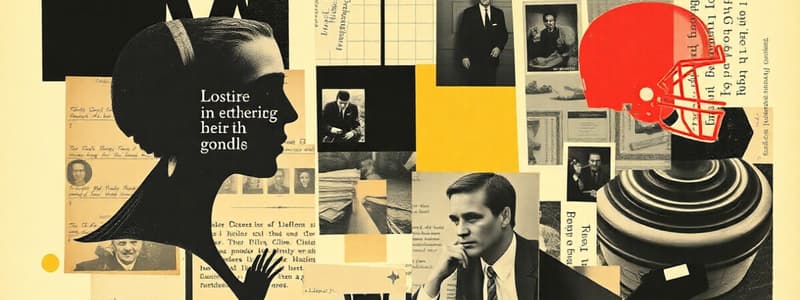Podcast
Questions and Answers
What distinguishes social media from legacy media regarding fake news?
What distinguishes social media from legacy media regarding fake news?
- Social media has made fake news an industry, whereas legacy media prohibits it. (correct)
- Both social media and legacy media allow for the same level of fake news.
- Social media prohibits fake news while legacy media does not.
- Legacy media is primarily responsible for spreading fake news.
What does the two-step flow model illustrate?
What does the two-step flow model illustrate?
- The influence of opinion leaders on societal opinions after receiving media messages. (correct)
- Direct transmission of media messages from creators to the public.
- The role of emotional responses in shaping public opinion.
- The independent understanding of media content by individuals.
What is a key characteristic of ethical media?
What is a key characteristic of ethical media?
- It prioritizes entertainment over factual information.
- It exclusively serves capitalist interests.
- It guarantees media quality while promoting solidarity and common good. (correct)
- It functions without regard for privacy concerns.
According to McLuhan's concept of 'Media as a Global Village', what does media do?
According to McLuhan's concept of 'Media as a Global Village', what does media do?
What factors influence media content significantly?
What factors influence media content significantly?
Which theory suggests that opinion leaders influence the opinions of others in society?
Which theory suggests that opinion leaders influence the opinions of others in society?
What does the term 'newsworthy' refer to?
What does the term 'newsworthy' refer to?
Which stage in the Diffusion process comes immediately after 'Knowledge'?
Which stage in the Diffusion process comes immediately after 'Knowledge'?
What role does 'trustworthiness' play in journalism?
What role does 'trustworthiness' play in journalism?
What does the T.R.U.T.H acronym in journalism stand for?
What does the T.R.U.T.H acronym in journalism stand for?
Which group in the Diffusion of Innovations model is characterized by being skeptical and resistant to change?
Which group in the Diffusion of Innovations model is characterized by being skeptical and resistant to change?
What is a primary characteristic of journalists according to the given descriptions?
What is a primary characteristic of journalists according to the given descriptions?
Which model suggests that media messages have a direct effect on the audience?
Which model suggests that media messages have a direct effect on the audience?
Flashcards
Media's Influence on Reality
Media's Influence on Reality
The media is not a neutral mirror of reality; it actively shapes our understanding of the world through its choices of what to cover and how to present it.
Two-Step Flow Model
Two-Step Flow Model
The process by which media messages are spread through society, starting with influential individuals who then share them with others.
Fake News in the Media
Fake News in the Media
Media, especially social media, presents information that may not be accurate or verified, often intentionally, for profit or influence.
Ethical Media
Ethical Media
Signup and view all the flashcards
Media Content
Media Content
Signup and view all the flashcards
What makes news newsworthy?
What makes news newsworthy?
Signup and view all the flashcards
Fact-Checking
Fact-Checking
Signup and view all the flashcards
Critical Reading
Critical Reading
Signup and view all the flashcards
Hypodermic Model
Hypodermic Model
Signup and view all the flashcards
Selective Exposure Theory
Selective Exposure Theory
Signup and view all the flashcards
Journalism
Journalism
Signup and view all the flashcards
Opinion Leader
Opinion Leader
Signup and view all the flashcards
Diffusion of Innovations
Diffusion of Innovations
Signup and view all the flashcards
Study Notes
Media, Culture and Society
- Media reflects opinions but isn't a mirror of reality
- Media is a business with responsibilities
- Social media is different from traditional media, with different standards and responsibilities
- The two-step flow model explains how opinion leaders spread media messages
- Media acts as a global village, connecting people regardless of location
- Media content includes entertainment, advocacy, advertisements, news, and opinions
- Ethical media promotes solidarity, supports the common good, and ensures privacy
- Ethical media prioritizes people over capital
- New media has brought digitalisation, increased interactivity, mobility, network connectivity, and changed publication/audience roles
- Society influences the media, including laws, education, religion, culture, and economics
Journalism
- Journalism involves gathering, assessing, creating and presenting news/information to the public
- Journalism demands transparency
- Journalism reports objective truth, including fact-checking
- Journalism needs to be trustworthy
- News is new information relevant to people's lives
- Newsworthiness means a story, event, or information is significant and noteworthy
- Journalists act as verifiers, sense-makers, witnesses, and investigators
- The T.R.U.T.H acronym (Timely, Relevance, Unusual, Tension/Trouble, Human Interest) outlines important criteria for news
- Fact-checking is essential in journalism for verifying accuracy and truthfulness
- Trustworthiness in journalism is significant for credibility and accuracy of information
- Journalism is essential in democratic societies
Studying That Suits You
Use AI to generate personalized quizzes and flashcards to suit your learning preferences.



